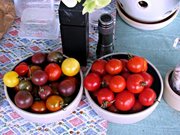GREEN SCENE
By Gardener Jack
For most home gardeners tomatoes are the prime crop. By your tomatoes shall ye be judged. Fortunately, tomatoes are ridiculously easy to grow. So easy that last year’s cherry tomato abundance will return in winter and grow like weeds.
Tomatoes originated in the foothills of the Andes and those eaten by the Incas (along with colourful potatoes) were small and probably yellow. Centuries of breeding led to red being the dominant tomato colour. In Europe a tomato the size of a small dessert apple is favoured while Americans prefer tomatoes closer to softball size.
Were you to go on the Internet and look up a few specialist seed house offerings you may be staggered by the number of tomato varieties on offer. Cherry, grape, paste, salad, beefsteak, heirloom, hybrid, red, pink, yellow, black, brown, orange, green – and combinations thereof – give the home gardener an avalanche of options.
For the beginner who may be overwhelmed, I would recommend a hybrid variety that includes the words ‘boy’ or ‘girl’, such as Early Girl or Big Boy. These are reliable performers and give good crops.
The experienced gardener needs no help from me but I would recommend Big Mama, a hybrid from Burpee that gave me great satisfaction last year. It is like Roma on steroids. For salad tomatoes I would recommend black tomatoes from Ukraine, Cherokee Purple, and, for slicing, German Pink.
Tomatoes can be started in pots or seedbeds and transplanted to the garden when they have established several sets of leaves. Damping off is a problem at this time of year and the soil should be sprayed with a fungicide before the seeds go in.
Tomatoes can also be sown directly into the ground where you wish them to grow. The problem here is that if one or two fail you have gaps in the garden. If you sow two or three seeds in each location you can then remove the weaker specimens and will have transplants to fill any gaps.
Before seeds are sown or transplants made the soil should be made ready with a conditioner like commercial cow manure or peat moss, have fertilizer added, and then watered for about a week. Time-release fertilizer can be added to the soil beneath the seed or transplant location.
Most medium or large tomato varieties will not set fruit if the temperature is above 68 degrees F. Our summer nights are warm but by the end of October we will experiencing cooler nights and if tomato plants are flowering then we will have the earliest returns possible. Tomato plants that set fruit in mid to late October will produce ripe fruit by the end of November or early December – well before Christmas.
With tomatoes and most other vegetable crops it is important to keep the crops coming. A new set of tomatoes should be started every month to six weeks. If things are done right you will have tomatoes in abundance from December to June or July.
Some tomatoes can be grown with one stick for support. Others are best dealt with using a tomato cage about five feet tall. Some tomatoes are determinate and die off shortly after their main harvest. Others are indeterminate and can produce fruit for months, though with decreasing returns. Indeterminate tomatoes can spread for 10-14 feet. Check the expected height of your tomato plants and deal with the plants accordingly. If tomato cages are not available you can keep the fruits off the ground by using milk crates or something similar. Tomatoes should never touch the ground.
Tomatoes are fast growers and therefore need a bountiful supply of water. Irregular watering will promote blossom-end rot and you will lose lots of tomatoes that are on the verge of ripening.
The joy of slicing and eating your own tomatoes makes up for all the work you have to do. Supermarket tomatoes are bred for shipping, not for taste. A good tomato variety sun-ripened in your own yard is a whole different experience.
–
• j.hardy@coralwave.com





Comments
Use the comment form below to begin a discussion about this content.
Sign in to comment
Or login with:
OpenID